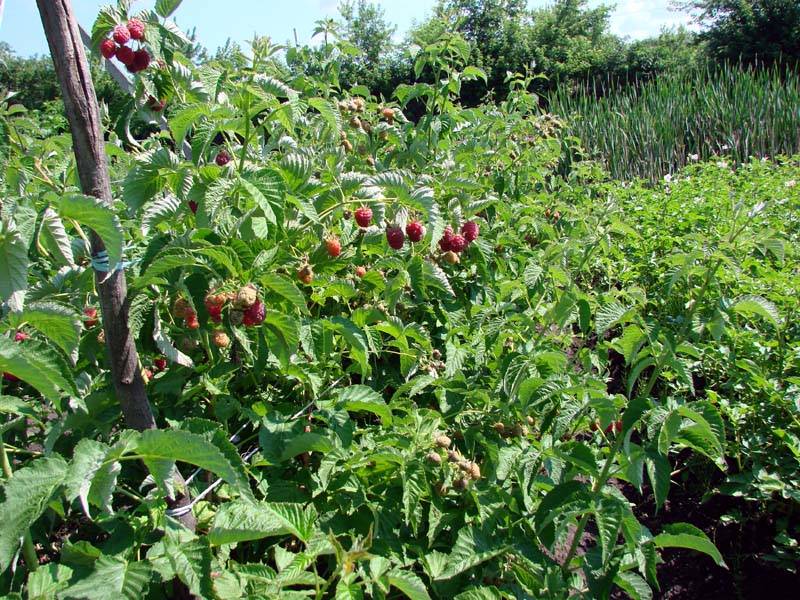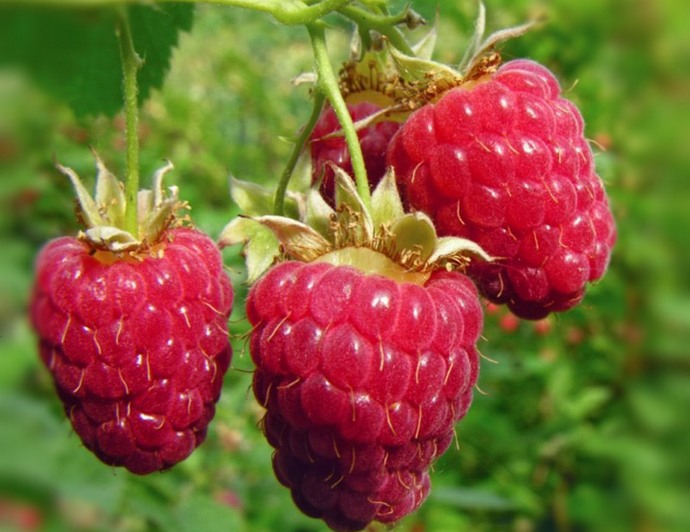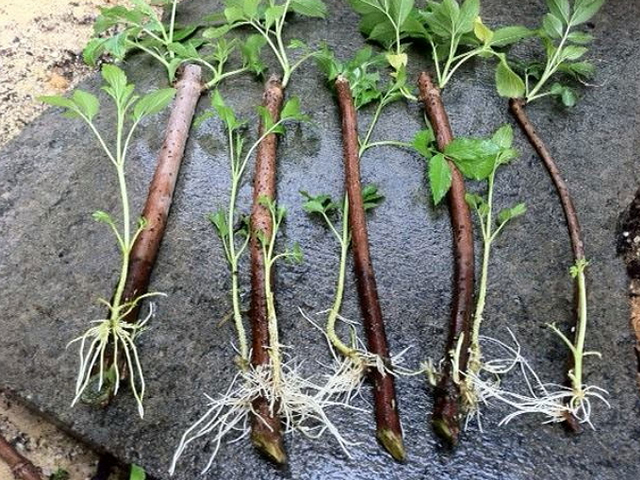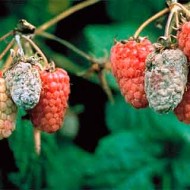Prospects and problems of growing remontant raspberries Monomakh's cap
Content
- 1 History of raspberry breeding Monomakh's hat
- 2 Botanical description of the variety
- 3 Video "Description of the variety of raspberries Cap of Monomakh"
- 4 Varietal characteristics
- 5 Advantages and disadvantages of the variety
- 6 Specificity of cultivation and reproduction
- 7 Protection from pests and diseases
- 8 Gardeners reviews
History of breeding raspberries Cap of Monomakh
The Shapka Monomakh variety was bred at the end of the 20th century. Its selection was carried out by I.V. Kazakov, who created the first domestic remontant raspberry. This variety was one of his most beloved and thoughtful. When breeding it, a well-known breeder took into account the peculiarities of the climate, illumination and the possibility of pollination. Kazakov also developed guidelines for the care of Russian remontant raspberries.
Botanical description of the variety
Monomakh's hat is a neat bushes or small trees with large juicy berries. Raspberries bear fruit abundantly and decorate the summer cottage thanks to their miniature shape and foliage that does not turn yellow before frost.
Ornamental characteristics of the bush
Remontant raspberry bushes of this variety grow up to 150–170 cm. This height is considered ideal for harvesting. Leaves are bright green, regular heart-shaped.

Shoots are thick, powerful, highly branched. At the ends, they may drop slightly under the weight of the berries. Stems at the root are woody, covered with thin thorns. At a height of 30–40 cm they disappear, so you can easily move between the bushes. Shoots near the roots grow very rarely and are easily eliminated.
Commercial quality of berries
Berries Monomakh's caps are large, weighing from 7 to 12 g. With proper care, record holders can grow up to 20 g. The shape of the fruits is triangular, elongated, rounded at the end.

The color is bright red or dark pink. The pulp is fleshy, juicy. The ripe berry is easily separated from the stalk and is not damaged during picking.
Video «Description of the raspberry variety Monomakh Hat»
From this video you will learn about the features of this kind of remontant raspberry.
Varietal characteristics
Gardeners who planted Monomakh Hat raspberries on their site speak well of it and note the annual high yield and excellent taste.
Fruiting
Monomakh's hat, like all remontant raspberries, bears fruit twice a season.
The first harvest ripens in the first decade of July in the south and in the middle of the month in the north. It is he who is best suited for sale.
The berries are large, juicy, and retain their ideal presentation. The second harvest ripens by mid-August. Berries are suitable for jam and compotes.
Yield
Monomakh's hat gives high yields – average 4–5 kg per bush per season. But experienced gardeners say that with proper care, 7–8 kg. To increase yields, they recommend adjusting watering and keeping the bushes from drying out. This will increase the number of berries and their size.
The taste and scope of berries
The taste of remontant raspberries is sweet, but not cloying, with a characteristic slight sourness. Raspberries can be eaten neat or ground with sugar. The berries make an amazing jam with a pleasant taste and a beautiful rich color. The housewives will also delight the jam or jam made from it. Monomakh's hat can be used as an ingredient in compotes. She will give new notes of taste and a rich raspberry color. Winemakers claim that you can get delicious dessert wine from it.
Advantages and disadvantages of the variety
- pleasant taste and favorable presentation of berries;
- high productivity;
- lack of thorns;
- no difficulties in transporting berries;
- frost resistance up to -25 ° C;
- relative ease of growing.
- susceptibility to diseases and pests;
- dependence on weather conditions;
- the difficulty of reproduction;
- the need for constant watering.
Specificity of cultivation and reproduction
The peculiarities of caring for the Hat Monomakh variety were described by its breeder I. Kazakov. Like any kind of remontant raspberry, it requires specific growing conditions for abundant fruiting.
Landing rules
In regions with mild winters, raspberries are most often planted in autumn, and in the north – in the spring. The procedure should be started in warm weather, so as not to injure young seedlings. The depth of the planting pit should be 30–35 cm length and width – from 25 to 30 cm. The distance between seedlings should not be less than 100 cm. A mixture of superphosphate, ash and compost is placed in the recess. It should cover the bottom of the pit.

After that, the seedling is placed in the center of the hole, making sure that the root collar is flush with the soil. Then the holes must be watered 8–10 liters of water and mulch to slow down drying.
Reproduction methods
Repaired raspberries are difficult to propagate at home. Most often this is done with seedlings. This is the easiest and most reliable way. Some also practice propagation by cuttings. To do this, in the spring, young shoots are carefully pruned underground at a depth of 5–7 cm. Then they are dug out, be sure to keep the soil on the roots. After planting in the holes, they are watered abundantly.

This procedure can be carried out in the fall. Then the cuttings are stored in boxes, and in the spring they are planted in a sand-peat mixture. This method is more problematic, since there is a risk of overdrying the cuttings during wintering. From this they die.
Watering and feeding raspberries
The Monomakh cap is more susceptible to watering than other varieties. In dry, sunny weather, it can be watered daily or every other day. If it's cool outside, then the amount of moisture can be reduced to 1 time in 2–4 days. Water it in the morning, before the heat wave, or in the evening, when the air temperature has already dropped. When irrigating, do not allow water to enter the leaves.
After watering and in rainy weather, the soil must be regularly loosened to ensure the flow of air to the roots and prevent them from rotting.
To increase yields and promote plant health, they can be fed with diluted chicken droppings or manure. The procedure is carried out once in the spring, during the ovary of the fruit. In the middle of summer, nitrogen is added, at the end – potassium and phosphorus. Raspberries are not fed in autumn.
Pruning bushes
Pruning is carried out to increase yields and preserve the attractive appearance of the bushes. You can start the procedure after frost. Last year's branches, which have already borne fruit, are cut at the root. The tops of the young are plucked. I. Kazakov even allowed the pruning of all shoots to avoid freezing.

The cut parts of the plant are burned to destroy pests and diseases.
Protection from pests and diseases
The weak link of the Monomakh Hat is its susceptibility to diseases and parasites. Most often, it is infected by bushy dwarfism, popularly known as looseness. The berries become small, divided into grains and easily crumble from the bush. Yellow streaks appear on the leaves, they wither and sink. If you notice the disease in time, you can remove the affected area and burn it. If signs of disease appear on most of the plant, you have to get rid of the entire bush in order to avoid contamination of healthy seedlings.
The raspberry beetle appears on the site in spring and early summer when raspberries are in bloom. It feeds on buds, which affects the amount of the crop. Therefore, during flowering, pests can be removed mechanically, or the bushes can be treated with Confidor.
There are frequent cases of lesions of remontant raspberries with a spider mite. The leaves turn gray and fall off the bush. To fight the tick, the bushes are treated with colloidal sulfur or Karbofos.
Gardeners reviews
Experienced gardeners and amateur gardeners who planted the Monomakh Hat in their backyard plots speak of its fertility and the pleasant taste of berries.
Repaired raspberry Monomakh hat – a new variety that is deservedly distributed among Russian gardeners. With timely watering and proper pruning, it will bear fruit abundantly. Disease prevention will prevent infections and parasites from destroying crops.






